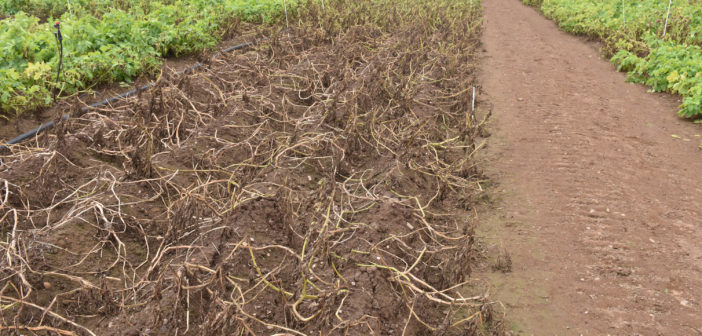A surge in late blight pressure on the independent Eurofins trials site in Derbyshire has developed into one of the best tests of potato blight fungicides for many years.
One trial, designed to mirror the Euroblight categorisation under UK conditions and native blight strains, has underlined the importance of the rating, along with some interesting developments during 2017, reported Syngenta Potato field technical manager, Douglas Dyas.
This year one trial protocol tested 13 different fungicides with single product use at weekly application right through the season; infector rows between plots were inoculated with strains of blight and managed to induce high blight pressure across the site.
“Although in practice all growers and agronomists would select and alternate different blight products in a programme through the season, the trial is a genuine test of any fungicide active’s true capability, and how it performs under UK conditions with evolving blight strains,” advocated Douglas.
He pointed out that this season has really pulled out some of the significant effects caused by different strains of the potato blight pathogen, and the challenges that created for agronomists and growers.
“There had been increasing concerns over the continued effectiveness of fluazinam under the pressure of the specific blight strain, Dark Green EU-37,” he recalled. “Through the main part of the season the continued use of straight Shirlan had looked extremely good, then through the end of August it collapsed; possibly indicating that Dark Green EU-37 had come into the crop via natural infection.
“Fluazinam remains an extremely important tool for its zoospore activity to prevent tuber blight infection, so this trial has fully supported the advice intended to minimise the risk of the resistant strain building up. That has included to always alternate applications with another active; to mix a partner product such as mancozeb and/or cymoxanil; to maintain robust rates and to limit the overall use of fluazinam,” he advised.
The independently assessed trial had also shown some other fluazinam mixtures such as fluazinam + dimethomorph and fluazinam + cymoxanil, along with dimethomorph + amectoctradin, to be losing efficacy as the season progressed.
Douglas highlighted another set of replicated trial plots, where Fubol Gold (mancozeb + metalaxyl-M) had remained almost completely free of blight through to the end of the August assessments. Although the adjacent infector rows were inoculated with the Blue 13 A2 blight strain – which had historically shown resistance to phenylamide bight fungicides – the treatment had very effectively stopped foliar blight developing.
“The highly systemic nature of Fubol Gold does have some real value for use in the rapid canopy phase of crop growth. Agronomists visiting the trials indicated they see it may have a potential role at that timing, albeit for limited use and possibly in mixtures to counter risk of Blue 13 resistance issues,” he added.
The trials had also reinforced how mandipropamid products had remained at the top of the Euroblight table over many years, and continued to perform exceptionally well in the Eurofins UK equivalent.
“Revus was still the top performing straight active in the trials,” reported Douglas. “At the end of August, when severity of blight infection had reached over 90% in untreated plots, the independently assessed Revus plots showed just 0.01% blight severity.
“Furthermore, although the trial was not looking at Alternaria, we included Amphore Plus (mandipropamid + difenoconazole) in the protocol to assure its comparative late blight performance. In fact, it proved even better – with no visible blight recorded in the end of August assessment,” said Douglas. He attributed that could be due to the formulation of the co-product mixture that had further enhanced the blight control, rather than the difenoconazole acting on the late blight strains.
Full results of the Eurofins trial will be available at the Harrogate Potato Event in November, and at Syngenta Potato Science Live meetings next spring.




